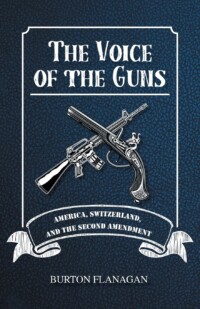Title: The Voice of the Guns
Subtitle: America, Switzerland, and the Second Amendment
Author: Burton Flanagan
Publisher: AuthorsPress
ISBN: 978-1-64314-859-5
Pages: 15
Genre: Non-Fiction / Legal Analysis
Reviewer: Beth Adams
Pacific Book Review
Author Burton Flanagan postulates a very powerful argument in his book, which reads such as a legal opinion, on the wording of the Second Amendment’s meaning regarding the right to bear arms.
The Voice of the Guns: America, Switzerland, and the Second Amendment,begins with a Supreme Court decision in the case of Heller vs. District of Columbia. The Supreme Court, with the summary opinion written by Justice Antonin Scalia, upheld the right of Dick Heller, a special police officer seeking to keep a firearm at home, which was initially denied by the DC application, appealed and upheld by the Federal District Court, then sought injunctive relief all the way up to the Supreme Court, at which point the decision was overturned in Heller’s favor.
As many nowadays understand, “A well-regulated militia being necessary to the security of a free state, the right of the people to keep and bear arms shall not be infringed.” The Second Amendment was ratified in 1791. However, it is argued that the right is only awarded to maintain a militia, and does not apply to ordinary citizens, including at that time women and blacks. Further legal depiction goes on the quote Hamilton in the Federalist #8, stating that it is not a right of all people, just as the First Amendment of Freedom of Speech is also limited, forbidding a person to yell “fire” in a crowded area. This view is quite interesting even given the forensic analysis of the grammar used in the 18th century vs. how we use grammar today. Basically, if all persons are born with the right to own firearms, then the amendment should have taken out the reason to “maintain a well-regulated militia.”
To further Flanagan’s argument, he cites a summary of Switzerland, and how the gun laws of that county are used. You see; by allowing the freedom of gun possession to everyone (even having mentally unstable characters own weapons), you are not protecting the rights of a very large group of citizens – those being the victims of gun violence. As proof the author cites the statistics of school shootings of these two countries – a sobering realization of the ramifications of blanketed rights to bear arms. It must be noted that automatic and semi-automatic weapons were never allowed in the 2nd Amendment.
As the United States is backed by faction groups of gun owners, hunters, military and others, being criticized by advocates of groups defending the rights of victims of gun violence, this 2nd Amendment issue is at the core of the legal framework, and will no doubt become the root for legal dissertation. Flanagan’s work not only educates but also encourages reflection, leaving readers with a deeper understanding of the intricate relationship between guns, governance, and society. The Voice of the Guns: America, Switzerland, and the Second Amendment, in its brevity and clarity, is a good book for all to use to understand this issue more clearly, or as a tool to discuss the merits of the Constitutional Amendment. For readers interested in history, politics, and the ongoing global debate about gun control, The Voice of the Guns is an indispensable read.


